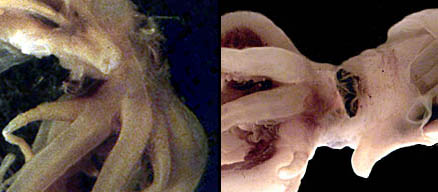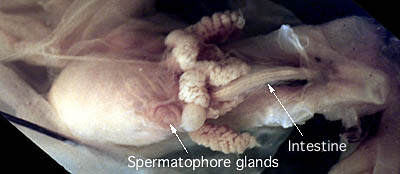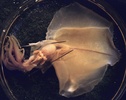Magnapinna sp. C
Michael Vecchione and Richard E. YoungIntroduction
A magnapinnid, illustrated by Hardy (1956) from the South Atlantic and identified as Octopodoteuthopsis, is deposited in the Natural History Museum, London (BMNH). This squid was recognized as a magnapinnid by Vecchione and Young (2006). They list this species as Magnapinna sp. due to the slender tentacles which differed greatly from the previously only known species, M. pacifica.
Diagnosis
A Magnapinna ...
- with proximal-tentacles more slender than arms IV.
- with chromatophores.
- without glandular regions on proximal-tentacles.
Characteristics
- Arms
- Proximal-arms approximately subequal in length (ca 40-45% of ML).
- Proximal-arms with gelatinous consistency and thick protective membranes.
- Arm tips stripped and damaged, distal-arms not recognizable.
- Proximal-arm suckers closely spaced, in 2 series.
- Proximal-arm suckers globular with smooth rings.
- Tentacles
- Tentacles badly damaged, suckers absent.
- Tentacle diameter at base less than arm diameter.
 Click on an image to view larger version & data in a new window
Click on an image to view larger version & data in a new window
Figure. Left - Ventral view of the base of the brachial crown of Magnapinna sp. C, showing relative size of arm and tentacle bases. Right - Lateral view of the head, arms and tentacles of Magnapinna sp. C showing funnel locking apparatus. Photographs by Wen-Sung Chung.
- Funnel
- Funnel locking-apparatus oval, without tragus or antitragus.
- Funnel locking-apparatus oval, without tragus or antitragus.
- Mantle
- Mantle length 79 mm.
- Mantle length 79 mm.
- Fins
- Fin length 59 mm (75% of ML); width 76 mm.
- Fins in terminal position.
- Fins attach to lateral sides of gladius.
- Photophores
- Photophores absent.
- Viscera
- Spermatophore glands present.
Comments
We examined the specimen in the year 2000 before we realized that it belongs to the Magnapinnidae. The brief description above is from some notes we made at the time. The arms and tentacles were badly damaged in capture. The squid is an immature male. The buccal mass is relatively large and the buccal membrane is very reduced. We are uncertain at present whether this represents a separate species or is conspecific with M. atlantica and/or M. talismani. This specimen needs to be re-examined.
References
Vecchione, M. and R. E. Young. 2006. The squid family Magnapinnidae (Mollusca; Cephalopoda) in the North Atlantic with a description of Magnapinna atlantica, n. sp. Proc. Biol. Soc. Wash. 119 (3): 365-372.
Title Illustrations

| Scientific Name | Magnapinna sp. C |
|---|---|
| Location | South Atlantic |
| Specimen Condition | Dead Specimen |
| Sex | Male |
| View | Ventral |
| Size | 79 mm ML |
| Copyright | © Wen-Sung Chung |
About This Page

National Museum of Natural History, Washington, D. C. , USA

University of Hawaii, Honolulu, HI, USA
Page copyright © 2019 and
 Page: Tree of Life
Magnapinna sp. C.
Authored by
Michael Vecchione and Richard E. Young.
The TEXT of this page is licensed under the
Creative Commons Attribution-NonCommercial License - Version 3.0. Note that images and other media
featured on this page are each governed by their own license, and they may or may not be available
for reuse. Click on an image or a media link to access the media data window, which provides the
relevant licensing information. For the general terms and conditions of ToL material reuse and
redistribution, please see the Tree of Life Copyright
Policies.
Page: Tree of Life
Magnapinna sp. C.
Authored by
Michael Vecchione and Richard E. Young.
The TEXT of this page is licensed under the
Creative Commons Attribution-NonCommercial License - Version 3.0. Note that images and other media
featured on this page are each governed by their own license, and they may or may not be available
for reuse. Click on an image or a media link to access the media data window, which provides the
relevant licensing information. For the general terms and conditions of ToL material reuse and
redistribution, please see the Tree of Life Copyright
Policies.
- First online 16 August 2005
- Content changed 26 March 2019
Citing this page:
Vecchione, Michael and Richard E. Young. 2019. Magnapinna sp. C. Version 26 March 2019 (under construction). http://tolweb.org/Magnapinna_sp._C/52211/2019.03.26 in The Tree of Life Web Project, http://tolweb.org/











 Go to quick links
Go to quick search
Go to navigation for this section of the ToL site
Go to detailed links for the ToL site
Go to quick links
Go to quick search
Go to navigation for this section of the ToL site
Go to detailed links for the ToL site